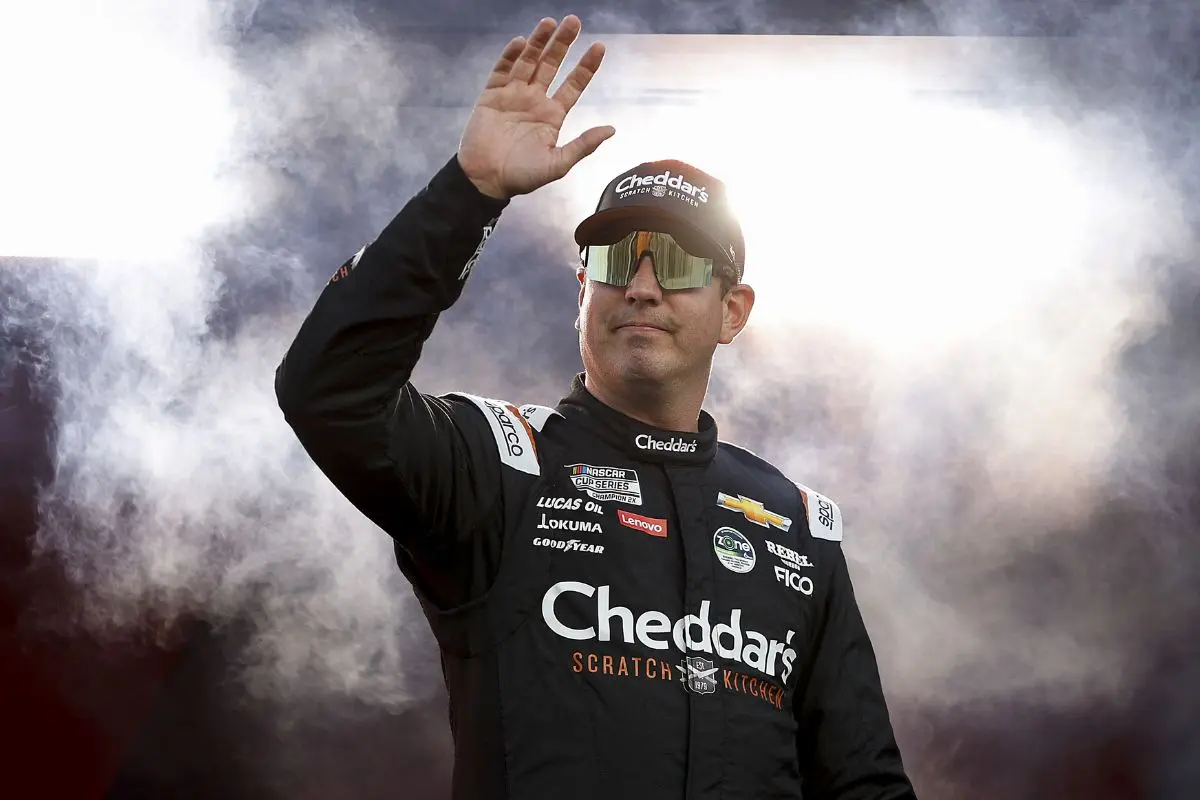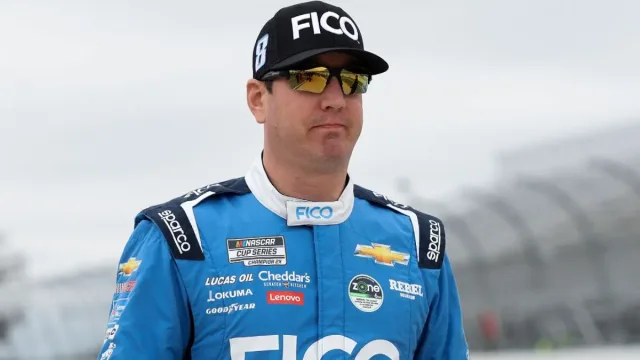Kyle Busch‘s dirt racing reality check revealed some shocking truths about his experience in the world of dirt racing. Although Kyle Busch is a seasoned NASCAR driver with plenty of success, stepping into the dirt racing world brought unexpected challenges. As he faced fierce competition on the dirt track, it became clear that the experience was unlike anything he had encountered before. What did Kyle Busch learn from this new experience?
Key Highlights
- Handling kerbs in midget racing was a significant concern due to their impact on vehicle control.
- Mechanical failures, like the exhaust issue, were a major worry during the Chili Bowl experience.
- Adapting to the unique track conditions of dirt racing posed a challenge for Kyle Busch.
- The variability in track conditions required constant strategy adjustments, raising concerns for Busch.
- The heightened risk of accidents on dirt tracks was a significant worry for Busch during his debut.
Kyle Busch’s Motorsport Legacy and Transition to Dirt Racing
Although Kyle Busch‘s reputation as a dominant force in motorsports is well-established, his shift to dirt racing marks a considerable evolution in his career. Known for his unparalleled success across NASCAR’s premier series, Busch’s decision to investigate the dirt track arena highlights his willingness to diversify and challenge himself, despite his storied history on asphalt.
With 63 NASCAR Cup Series wins, two championship titles, and an impressive total of 231 victories across NASCAR’s national series, Busch has long been a formidable competitor. However, his recent foray into dirt racing is indicative of a tactical pivot, likely influenced by personal motivations and family involvement.
The catalyst for Busch’s change to dirt was his son Brexton, whose growing interest in the discipline prompted Busch to examine this new frontier. Participating alongside Brexton at events such as Millbridge Speedway and the Tulsa Shootout, Busch not only supported his son’s aspirations but also accepted the opportunity to expand his own racing repertoire.
This venture culminated in his debut at the prestigious Chili Bowl Nationals, a notable milestone in his dirt racing expedition.
Busch’s entry into the dirt racing sphere is not merely a personal endeavor but a calculated move to broaden his competitive scope. By engaging with the dirt track community, Busch demonstrates his adaptability and continuous quest for mastery in varying racing formats.

Kyle Busch’s Challenges on Dirt Tracks
As Kyle Busch ventures further into the realm of dirt racing, he encounters a distinct set of challenges that test his adaptability and skill. Dirt racing, with its unique track conditions and specialized vehicles, presents a pronounced contrast to the NASCAR circuits Busch is accustomed to. The shift from stock cars to midget cars introduces a complexity that even seasoned drivers like Busch find demanding.
One of the primary hurdles Busch faces is the handling of kerbs in midget racing. Unlike NASCAR, where kerbs have been minimized over the years to improve driver comfort and safety, dirt tracks offer a different challenge. In midget racing, kerbs are not just a safety measure but a dynamic element that greatly impacts vehicle control.
Busch has expressed concern over the increasing prominence of kerbs throughout the race week, noting, “You can kinda run up there with a smaller kerb. That’s my biggest worry. I have never run with that.”
“See, each night that progresses, last night being a kerb, earlier there wasn’t much of a kerb. You can kinda run up there with a smaller kerb. That’s my biggest worry. I have never run with that. I have never had to run with that. When we were at Ventura, or we were at Bakersfield, the track you know, you can kinda get up to the marbly stuff but it wasn’t really a kerb.” – Kyle Busch
View this post on Instagram
The sensitivity of midget cars to these track features adds to Busch’s apprehension. Unlike stock cars, which have the capacity to absorb impacts from kerbs, midget cars are delicate and more prone to losing stability.
Kyle Busch’s Midget Racing Debut at Bakersfield
Kyle Busch’s debut in the USAC NOS Energy Drink Midget National Championship at Bakersfield Speedway marked a notable moment in his racing career. The event, held during the eighth annual November Classic on Bakersfield Speedway’s 1/3-mile dirt oval in California, was a highly anticipated occasion, especially with Busch sharing the stage with fellow NASCAR Cup driver Kyle Larson.
Driving the #51 car for Kyle Busch Motorsports, Busch exhibited impressive speed and control during practice sessions, earning him commendations for the car’s setup and his handling skills.
Despite the promise shown during practice, the race unfolded with unexpected challenges. As Busch initially took the lead during heat #2, his performance took a dramatic turn when the car suddenly lost power as he entered Turn 2, with seven laps remaining. This mechanical failure was accompanied by flames erupting from the exhaust of his Lucas #51 midget, forcing Busch to withdraw from the event.
Busch’s debut, while ending prematurely, was a reflection of his adaptability and skill in the world of midget racing, showcasing his potential in this demanding discipline. The experience at Bakersfield provides valuable insights into the complexities of dirt racing, especially for a driver with a background in NASCAR.

Kyle Busch’s Performance at the Chili Bowl Nationals
The Chili Bowl Nationals presented a formidable challenge for Kyle Busch, showcasing both his potential and the unpredictable nature of dirt racing. His expedition through the event highlighted the complexities and demands of this unique motorsport.
In the initial heat race, Busch exhibited resilience and skill by advancing from a starting position of seventh to secure an impressive runner-up finish. This performance earned him a commendable third place overall standing, with a total of 118 points.
However, the subsequent phases of the competition revealed the capricious aspects of dirt racing. In the Friday evening qualifier, Busch began in fourth place but faced difficulties, ultimately finishing in seventh. This result necessitated his participation in the B-Main race, where, despite starting in the lead position, he encountered similar challenges and concluded in seventh place once more.
These outcomes reflected both the fierce competition and the inherent unpredictability of the sport, necessitating tactical insight and adaptability. Busch’s performance, while falling short of his aspirations for automatic qualification, remains a reflection of his rigorous preparation and collaboration with an experienced crew chief.
His ability to secure strong starting positions and initial performances speak to his potential in this demanding environment. As he moves forward to compete in the alphabet soup race on Saturday, Busch’s determination and tactical adjustments will be critical in his quest for another chance at qualifying.
Kyle Busch’s Preparation for the Chili Bowl Nationals
Busch’s expedition through the Chili Bowl Nationals highlighted both the challenges and his dedication to mastering dirt racing. Recognizing the need for specialized expertise, Busch enlisted the help of Al Scroggins, a seasoned dirt race crew chief, to guide his preparation for the event. Scroggins’ extensive experience in midget racing was invaluable, as he has collaborated with elite talents throughout his career.
“He (Scroggins) has been in this world for so long and knows everything and so much about these cars. He has worked with some of the top-tier talents that have been through the midget ranks.” – Kyle Busch
In his quest for excellence, Busch took a proactive approach by constructing his own midget car, a proof of his commitment to the sport. This vehicle underwent continuous modifications after each practice session, underscoring Busch’s careful attention to detail and relentless pursuit of improvement. His partnership with Scroggins allowed him to tailor the car’s performance to his precise specifications.
“I figured I’ve got one of the best guys that knows how to put them together and do it with, so let’s go do it ourselves and not have to worry about being a part of a 16-car team and not really getting the attention that we need.” – Kyle Busch
Busch’s calculated decision to avoid being part of a large team and instead focus on a more personalized setup illustrated his desire for autonomy and individualized attention. As he stated, working with Scroggins enabled him to circumvent the potential limitations of being within a larger team structure, thereby ensuring that his needs were prioritized.

News in Brief: Kyle Busch’s Dirt Racing Reality Check
The shift of Kyle Busch from traditional motorsport to dirt racing presents considerable challenges, particularly due to the unique dynamics of dirt tracks. Busch’s debut in midget racing at Bakersfield and his subsequent performance at the Chili Bowl Nationals highlight both the difficulties and learning curve associated with this form of racing.
His preparation for these events emphasizes the tactical adaptations needed to succeed, illustrating the complexity of mastering new racing disciplines while maintaining a competitive edge in a diverse motorsport landscape.
ALSO READ: Kyle Busch Needs Daytona 500 Win to Secure His Place Among NASCAR’s All-Time Greats
